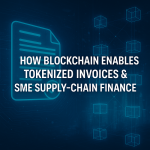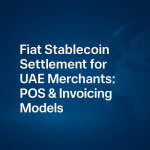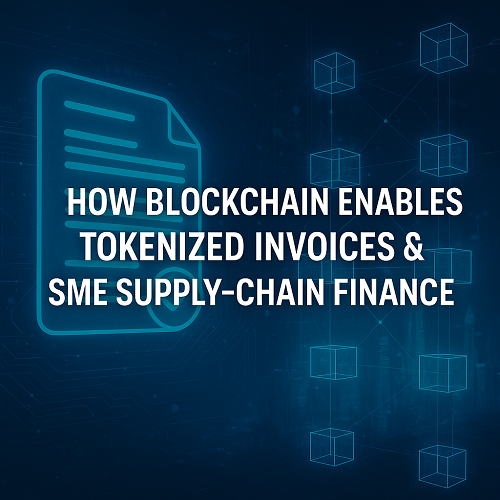Table of Contents
- Introduction
- What Is Invoice Tokenization
- Supply-Chain Finance Challenges for UAE SMEs
- How Blockchain Transforms the Model
- Tokenized Invoice Marketplaces in Dubai
- Key Benefits for SMEs and Anchor Buyers
- Implementation and Ecosystem Requirements
- UAE Legal and Regulatory Landscape
- Risks and Operational Challenges
- Market Outlook and Future Trends
- Frequently Asked Questions (FAQs)
- Final Thoughts
- Websima’s Role in Enabling Blockchain Finance
Introduction
Across the United Arab Emirates, small and medium-sized enterprises (SMEs) are the backbone of the economy. Official guidance highlights their outsized contribution to output and employment, underscoring why access to efficient working capital is a national priority for competitiveness and diversification. See the UAE government’s overview of SMEs and entrepreneurship for context on the sector’s importance and momentum. (UAE Government Portal: SMEs)
Yet many SMEs still wait 60–120+ days to be paid, juggle costly credit, and spend too much time on manual invoice administration. Invoice tokenization offers a structural solution: convert approved receivables into blockchain-based tokens to obtain early liquidity, automate settlement, and reduce disputes. In short, tokenization can transform a slow, opaque receivables process into a transparent, programmable, and investable asset class — perfectly suited to a trade hub like Dubai.
The United Arab Emirates has signed the Crypto-Asset Reporting Framework (CARF) developed by the Organisation for Economic Co-operation and Development (OECD) becoming one of the first countries to adopt international standards for tax transparency in the digital asset sector.… pic.twitter.com/fI2IqiHooZ
— ABONHYAN (@ABONHYANUAE) October 23, 2025
This article explains how invoice tokenization works, where it fits into supply-chain finance, the enabling technology and operating model, and the UAE-specific legal and operational considerations for building or adopting a tokenized invoice marketplace.
What Is Invoice Tokenization
Invoice tokenization converts a verified accounts receivable (an approved invoice) into a digital token on a blockchain. That token references key metadata (invoice number, buyer, amount, due date, and settlement instructions) and enforces rules via smart contracts (e.g., transfer restrictions, discount schedules, redemption logic).
Once issued, the token can be:
- Sold (similar to factoring) for early cash,
- Used as collateral for a short-term loan, or
- Traded in a marketplace or pooled into diversified receivables portfolios.
Crucially, the token’s value is tied to the invoice obligation and the anchor buyer’s credit quality — not just the seller’s standalone profile. This feature extends affordable liquidity deeper into the supply chain (tier-2 and tier-3 suppliers) and reduces concentration risk for financiers.
Supply-Chain Finance Challenges for UAE SMEs
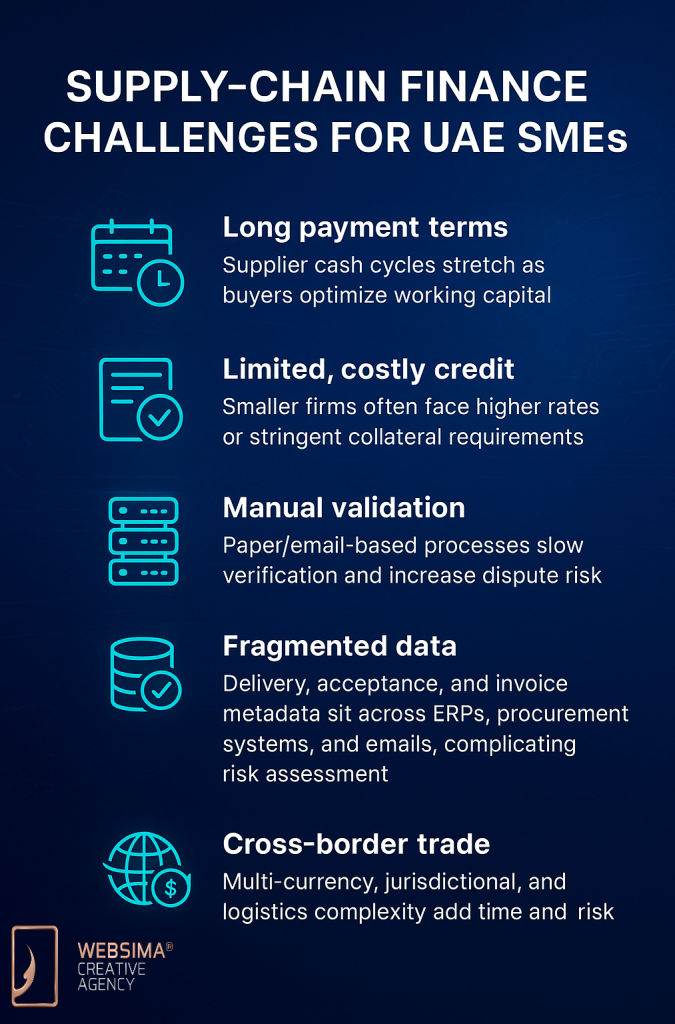
UAE SMEs confront persistent friction in receivables management:
- Long payment terms: Supplier cash cycles stretch as buyers optimize working capital.
- Limited, costly credit: Smaller firms often face higher rates or stringent collateral requirements.
- Manual validation: Paper/email-based processes slow verification and increase dispute risk.
- Fragmented data: Delivery, acceptance, and invoice metadata sit across ERPs, procurement systems, and emails, complicating risk assessment.
- Cross-border trade: Multi-currency, jurisdictional, and logistics complexity add time and risk.
Invoice tokenization turns each invoice into a programmable, verifiable asset, creating a pathway for faster, cheaper, and broader access to financing — especially when paired with robust identity, KYC/AML, and data-protection practices.
How Blockchain Transforms the Model
Immutable Transparency
A distributed ledger records invoice issuance, token creation, transfers, and settlement events. The resulting audit trail reduces fraud (e.g., double-financing the same invoice) and streamlines verification for financiers and auditors.
Smart-Contract Automation
Smart contracts encode business logic: early-payment discounts, notifications on buyer acceptance, net-of-credit-note adjustments, and redemption rules at maturity. This automation compresses settlement timelines, reduces manual work, and lowers operational cost.
Liquid, Investable Instruments
Tokenized invoices can be sold or syndicated to banks, funds, or qualified investors. As marketplaces mature, secondary trading improves price discovery and liquidity, aligning supply (SME receivables) with demand (short-duration yield).
Deep-Tier Inclusion
Because risk is primarily tied to anchor-buyer credit, tokenization allows upstream suppliers to benefit from lower financing costs and consistent cash flow, improving resilience across entire value chains.
Tokenized Invoice Marketplaces in Dubai
A fit-for-purpose marketplace for invoice tokenization UAE typically includes:
- Onboarding & Verification
- Seller and buyer KYC/AML; ERP integration to ingest invoice and delivery/acceptance data; fraud checks to prevent duplicates.
- Token Issuance
- Approved invoices are minted as tokens with metadata (amount, due date, debtor) and constraints (transferability, investor eligibility).
- Primary Financing
- Investors purchase tokens (at a discount to face value) to provide early liquidity to sellers. Proceeds settle to the seller’s bank account or e-money wallet.
- Secondary Liquidity
- Tokens may trade prior to maturity, enabling portfolio management and risk redistribution.
- Settlement & Redemption
- Upon buyer payment at maturity, smart contracts distribute funds to token holders net of fees, with automated reconciliation.
- Risk, Reporting & Analytics
- On-chain data supports real-time dashboards for exposure, delinquencies, and concentration risk; standardized reporting accelerates audits.
In Dubai’s context — with dense trade corridors, sophisticated buyers, and a forward-leaning regulatory environment — well-designed marketplaces can operate permissioned (for privacy) while still enabling interoperability with banks, custodians, and payment rails.
Key Benefits for SMEs and Anchor Buyers
SMEs
- Faster cash, lower cost: Monetize approved receivables immediately, often at better rates than unsecured loans.
- Process efficiency: Less paperwork, fewer disputes; automatic status updates and reconciliation.
- Growth capacity: Recycle working capital into inventory, hiring, or new contracts.
Anchor Buyers
- Supply-chain resilience: Liquidity reduces supplier distress and delivery risk.
- Dynamic discounting optionality: Buyers can offer early payment terms competitively, or co-fund pools for strategic suppliers.
- Operational control: Standardized data and on-chain confirmations enhance governance and ESG transparency.
Financiers & Investors
- Verified assets: Traceable invoice lifecycle and buyer acceptance reduce due-diligence costs.
- Short-duration yield: Access to diversified pools of high-quality receivables.
- Programmable risk: Smart-contract rules tailor eligibility, limits, and redemption logic.
For a wider macro view of how trade-tech (including tokenization) is reshaping logistics and trade finance, see the World Economic Forum’s 2024 program report on catalyzing innovation across logistics, trade finance, carbon, and compliance. (WEF TradeTech 2024)
Implementation and Ecosystem Requirements
Building a tokenized invoice solution that meets UAE enterprise and regulatory standards requires coordination across technology, legal, and operations.
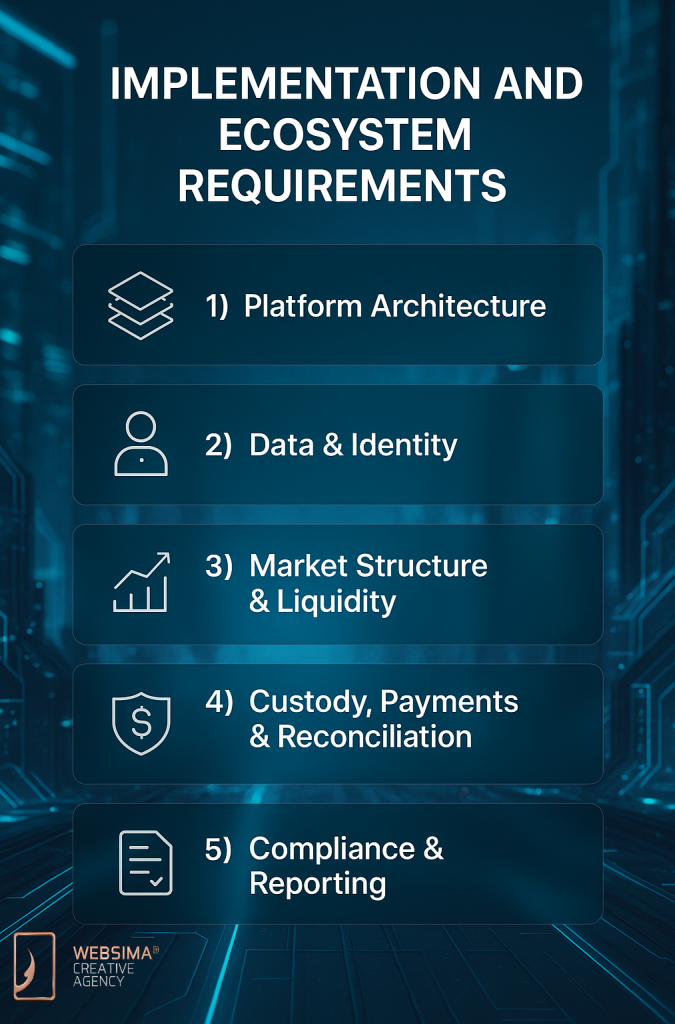
1) Platform Architecture
- Blockchain layer: Permissioned networks (e.g., enterprise EVMs or Corda-style ledgers) to balance privacy with interoperability.
- Smart contracts: Issuance, transfer controls, discount schedules, maturity/redemption, default waterfalls.
- APIs & integrations: Bidirectional syncing with ERP, procurement, e-invoicing, and banking systems (for payouts and collections).
2) Data & Identity
- KYC/AML for sellers, buyers, and investors; beneficial ownership checks; sanctions screening.
- Invoice authenticity: Delivery/proof-of-acceptance validations; uniqueness checks to prevent duplicate financing.
- Access controls: Role-based permissions; tamper-evident logs.
3) Market Structure & Liquidity
- Primary market for new issuances; secondary market for transfers; liquidity pools for diversified exposure.
- Risk models based on buyer credit, sector, tenor, and historical performance; portfolio guidelines and concentration limits.
4) Custody, Payments & Reconciliation
- Digital-asset custody with institutional key management (MPC/multi-sig), insurance, and disaster recovery.
- Collections via domestic rails, cross-border rails, or CBDC pilots (see below); automated reconciliation to investor wallets.
5) Compliance & Reporting
- Regulatory reporting on issuance volumes, investor eligibility, and suspicious activity; audit-ready records with standardized exports.
- Data protection policies (particularly for DIFC-based entities) and privacy-by-design architecture.
UAE Legal and Regulatory Landscape
A successful invoice tokenization UAE rollout must align with the country’s fast-maturing digital-asset and data-protection regime. Core references include:
- VARA Rulebooks (Dubai Mainland) — The Virtual Assets Regulatory Authority’s framework, including compulsory and activity-specific rulebooks (e.g., custody, broker-dealer, exchange, technology & information). These lay out licensing scopes, conduct, risk, and tech expectations for virtual-asset service providers. (VARA Rulebooks)
- DIFC Data Protection Law (Law No. 5 of 2020) — For entities operating from the DIFC, this law governs personal data processing, cross-border transfers, and controller/processor duties; marketplaces handling invoice and KYC data must adhere to its requirements. (DIFC Data Protection Law)
- CBDC and Financial Infrastructure Transformation (FIT) — The UAE’s FIT Programme includes a Central Bank Digital Currency (the Digital Dirham) initiative that, as it matures, can streamline settlement of tokenized assets and cross-border payments relevant to invoice redemption. (UAE: CBDC Strategy (FIT))
These references anchor licensing, data, and settlement design decisions. Platforms should obtain qualified legal advice to determine licensing category, token classification, and cross-border implications.
Risks and Operational Challenges
- Legal enforceability: Token terms must dovetail with invoice assignment laws and buyer consent; jurisdictional harmonization is key for cross-border receivables.
- Interoperability: Fragmented token standards and messaging formats can silo liquidity; prioritize open interfaces and market standards.
- Liquidity depth: Early ecosystems may face thin secondary markets; mitigate with anchor investors and diversified pools.
- Credit & concentration risk: Default risk still exists at the debtor level; manage with limits, insurance, or guarantees where suitable.
- Cybersecurity & custody: Smart-contract audits, key-management controls (MPC/multi-sig), and incident response plans are non-negotiable.
- SME readiness: Support onboarding, document digitization, and ERP connectors to reduce friction and data gaps.
- Operational change management: Train finance teams; clarify workflows for disputes, credit notes, and partial deliveries.
Market Outlook and Future Trends
- CBDC rail integration: As CBDC pilots progress, invoice-token settlement could become near-instant, with programmable escrow and atomic delivery-versus-payment. (See CBDC Strategy overview above.)
- Institutional RWA funds: Expect growth in regulated funds that buy diversified portfolios of short-duration receivables tokens.
- Deep-tier expansion: Anchor buyers will extend programs to sub-suppliers to stabilize supply and capture early-payment discounts more efficiently.
- AI-driven risk: On-chain histories and ERP telemetry will feed ML models for continuous credit scoring and anomaly detection.
- TradeTech standardization: Global efforts to harmonize messaging, data models, and cross-chain settlement will reduce fragmentation. For a broader view of the innovation agenda in trade finance and logistics, see the WEF’s TradeTech work. (WEF TradeTech 2024)
Frequently Asked Questions (FAQs)
What is invoice tokenization?
It’s the conversion of a verified receivable into a blockchain token with embedded rules for transfer and redemption, enabling financing or trading prior to maturity.
Why does this matter for UAE SMEs?
It unlocks faster, cheaper liquidity, standardizes verification, and reduces disputes — improving cash cycles without adding bank debt.
Do I need the buyer’s involvement?
Yes. Buyer acceptance/confirmation is central to token quality; many programs are buyer-led to anchor credit and reduce disputes.
Is it compliant in Dubai?
Platforms and service providers must operate within applicable licensing and technology rulebooks (e.g., VARA for virtual-asset activities) and comply with data-protection rules (e.g., DIFC Law No. 5 of 2020 for DIFC-based entities). See references above.
How do investors earn?
Investors buy tokens at a discount; at maturity the token redeems for face value upon buyer payment, with smart contracts distributing proceeds net of fees.
What role could CBDC play?
As the UAE’s CBDC/ Digital Dirham matures, settlement of tokenized invoices can be faster and more programmable, improving reconciliation and reducing FX/transfer friction.
Which industries benefit most?
Construction, logistics, wholesale/retail, FMCG distribution, and professional services — any sector with meaningful receivables and elongated payment terms.
What are the biggest risks?
Buyer default, legal enforceability across borders, custody/tech vulnerabilities, and early-stage market liquidity; all must be managed with policy, controls, and design.
Final Thoughts
Invoice tokenization aligns perfectly with the UAE’s push toward a digitized, resilient, and inclusive economy. By converting receivables into programmable assets, SMEs can accelerate cash flow, financiers gain transparent yield, and anchor buyers bolster supply-chain stability. With careful attention to licensing, data-protection, custody, and settlement design — and by leveraging emerging rails like CBDC — Dubai’s ecosystem can move from pilots to scaled, production-grade marketplaces that materially shorten working-capital cycles.
Websima’s Role in Enabling Blockchain Finance
At Websima, we help UAE organizations design, launch, and scale tokenized-finance solutions end-to-end:
- Architecture & Build: Smart-contract design, issuance & marketplace mechanics, ERP and banking integrations.
- Compliance-by-Design: Alignment with VARA rulebooks, data-protection frameworks (e.g., DIFC Law No. 5 of 2020), and AML/KYC workflows.
- Risk & Operations: Custody models (MPC/multi-sig), investor eligibility controls, audit trails, and reporting.
- Launch & Scale: Pilot structuring with anchor buyers, liquidity programs, and analytics for continuous improvement.
If your team wants to digitize receivables, create investor-ready invoice tokens, or explore CBDC-aligned settlement for supply-chain finance, we’d love to partner with you.
Start a conversation with Websima: https://websima.ae/contactus/

